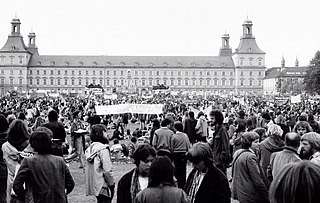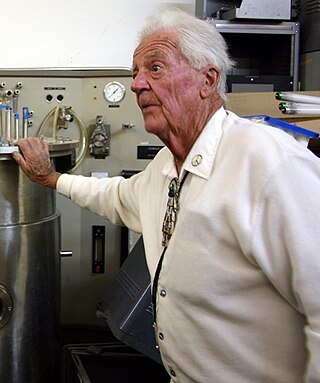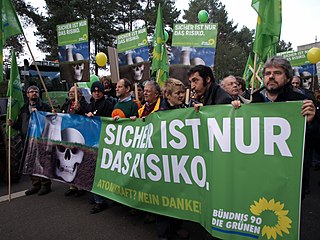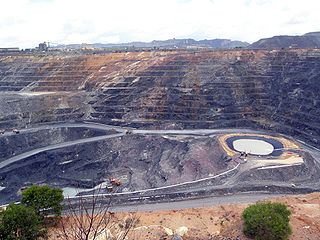Related Research Articles

International Physicians for the Prevention of Nuclear War (IPPNW) is a non-partisan federation of national medical groups in 63 countries, representing doctors, medical students, other health workers, and concerned people who share the goal of creating a more peaceful and secure world free from the threat of nuclear annihilation. The organization's headquarters is in Malden, Massachusetts. IPPNW was awarded the Nobel Peace Prize in 1985.

Helen Mary Caldicott is an Australian physician, author, and anti-nuclear advocate. She founded several associations dedicated to opposing the use of nuclear power, depleted uranium munitions, nuclear weapons, nuclear weapons proliferation, and military action in general.

The anti-nuclear movement is a social movement that opposes various nuclear technologies. Some direct action groups, environmental movements, and professional organisations have identified themselves with the movement at the local, national, or international level. Major anti-nuclear groups include Campaign for Nuclear Disarmament, Friends of the Earth, Greenpeace, International Physicians for the Prevention of Nuclear War, Peace Action, Seneca Women's Encampment for a Future of Peace and Justice and the Nuclear Information and Resource Service. The initial objective of the movement was nuclear disarmament, though since the late 1960s opposition has included the use of nuclear power. Many anti-nuclear groups oppose both nuclear power and nuclear weapons. The formation of green parties in the 1970s and 1980s was often a direct result of anti-nuclear politics.

The International Peace Bureau, founded in 1891, is one of the world's oldest international peace federations. The organisation was awarded the Nobel Peace Prize in 1910 for acting "as a link between the peace societies of the various countries". In 1913, Henri La Fontaine was also awarded the Prize "[For his work as] head of the International Peace Bureau". As of 2012, eleven other Nobel Peace Prize laureates have been members of the IPB.

Kevin Buzzacott, often referred to as Uncle Kev as an Aboriginal elder, is an Indigenous Australian from the Arabunna nation in northern South Australia. He has campaigned widely for cultural recognition, justice and land rights for Aboriginal people, and has initiated and led numerous campaigns including against uranium mining at Olympic Dam, South Australia on Kokatha land, and the exploitation of the water from the Great Artesian Basin.

The anti-nuclear movement in the United States consists of more than 80 anti-nuclear groups that oppose nuclear power, nuclear weapons, and/or uranium mining. These have included the Abalone Alliance, Clamshell Alliance, Committee for Nuclear Responsibility, Nevada Desert Experience, Nuclear Information and Resource Service, Physicians for Social Responsibility, Plowshares Movement, Women Strike for Peace, Nukewatch, and Women's International League for Peace and Freedom. Some fringe aspects of the anti-nuclear movement have delayed construction or halted commitments to build some new nuclear plants, and have pressured the Nuclear Regulatory Commission to enforce and strengthen the safety regulations for nuclear power plants. Most groups in the movement focus on nuclear weapons.
Maisie Shiell (1916–2008) became involved in anti-nuclear issues in 1976 when public concern developed about a new uranium mine in Saskatchewan. At sixty-one years of age, Shiell began learning how to translate highly technical issues about radioactivity into something she could understand and pass along to other lay people.
JoAnn Tall is an environmental activist of the Oglala Lakota tribe who has worked to ensure the people have a chance to approve major projects for energy development. She was awarded the Goldman Environmental Prize in 1993 for her protests against uranium mining and plans for testing nuclear weapons in the Black Hills area, near the Pine Ridge Indian Reservation where she lives.

Edward Bernard Grothus was an American machinist and technician at the Los Alamos National Laboratory during the 1950s and 1960s. In later life he became the owner of a surplus store which he used as a base for peace and anti-nuclear activism.

Nuclear weapons testing, uranium mining and export, and nuclear power have often been the subject of public debate in Australia, and the anti-nuclear movement in Australia has a long history. Its origins date back to the 1972–1973 debate over French nuclear testing in the Pacific and the 1976–1977 debate about uranium mining in Australia.

The anti-nuclear movement in Germany has a long history dating back to the early 1970s when large demonstrations prevented the construction of a nuclear plant at Wyhl. The Wyhl protests were an example of a local community challenging the nuclear industry through a strategy of direct action and civil disobedience. Police were accused of using unnecessarily violent means. Anti-nuclear success at Wyhl inspired nuclear opposition throughout Germany, in other parts of Europe, and in North America. A few years later protests raised against the NATO Double-Track Decision in Germany and were followed by the foundation of the Green party.
Anti-nuclear organizations may oppose uranium mining, nuclear power, and/or nuclear weapons. Anti-nuclear groups have undertaken public protests and acts of civil disobedience which have included occupations of nuclear plant sites. Some of the most influential groups in the anti-nuclear movement have had members who were elite scientists, including several Nobel Laureates and many nuclear physicists.
Yvonne Margarula is an Aboriginal Australian environmentalist who won the 1998 Friends of the Earth International Environment Award and the 1998 Nuclear-Free Future Award. She also won the 1999 US Goldman Environmental Prize, with Jacqui Katona, in recognition of efforts to protect their country and culture against uranium mining.

The prospect of nuclear power in Australia has been a topic of public debate since the 1950s. Australia has one nuclear plant in Lucas Heights, Sydney, but is not used to produce nuclear power, but instead is used to produce medical radioisotopes. It also produces material or carries out analyses for the mining industry, for forensic purposes and for research. Australia hosts 33% of the world's uranium deposits and is the world's third largest producer of uranium after Kazakhstan and Canada.
Sun Xiaodi has spent more than a decade petitioning the central Chinese authorities over radioactive contamination from the No. 792 Uranium Mine in the Gannan Tibetan Autonomous Prefecture in Gansu Province. In 2006, he received the prestigious Nuclear-Free Future Award.

The late 1950s and early 1960s saw a strong push from the Spanish Government to establish a national nuclear power industry. In response to the surge in nuclear power plant plans, a strong anti-nuclear movement emerged in 1973, which ultimately impeded the realisation of most of the projects.

Radioactive ores were first extracted in South Australia at Radium Hill in 1906 and Mount Painter in 1911. 2,000 tons of ore were treated to recover radium for medical use. Several hundred kilograms of uranium were also produced for use in ceramic glazes.

The uranium mining debate covers the political and environmental controversies of uranium mining for use in either nuclear power or nuclear weapons.
The William and Katherine Estes Award, previously known as the NAS Award for Behavioral Research Relevant to the Prevention of Nuclear War is awarded by the U.S. National Academy of Sciences "to recognize basic research in any field of cognitive or behavioral science that has employed rigorous formal or empirical methods, optimally a combination of these, to advance our understanding of problems or issues relating to the risk of nuclear war". It was first awarded in 1990.
The World Uranium Hearing was held in Salzburg, Austria in September 1992. Anti-nuclear speakers from all continents, including indigenous speakers and scientists, testified to the health and environmental problems of uranium mining and processing, nuclear power, nuclear weapons, nuclear tests, and radioactive waste disposal.
References
- ↑ "Statement of Mission".
- ↑ "NFFA Recipients and Locations".
- ↑ "PRESS ANNOUNCEMENT: THE NUCLEAR- FREE FUTURE AWARDS 2016". Earthlife Africa. Retrieved 12 April 2017.
- ↑ "Nuclear-free future awards 2012". Wise. Retrieved 12 April 2017.
- 1 2 3 4 The 2004 Nuclear-Free Future Award Recipients [ permanent dead link ]
- ↑ Jonathan Schell
- ↑ "The 2002 Nuclear Free Future Awards". Archived from the original on 2016-03-04. Retrieved 2008-12-19.
